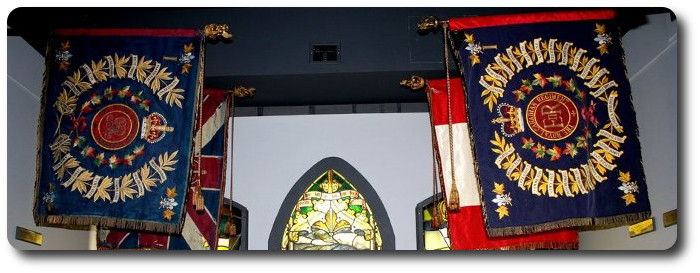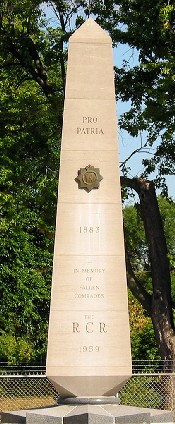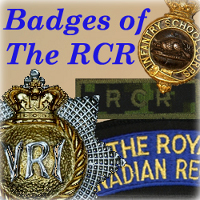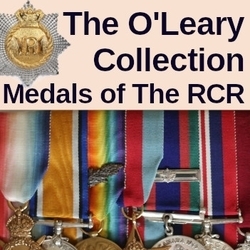
Researching The Royal Canadian Regiment
The Royal Canadian Regiment
Regimental Catechism 1883-1941

The Regimental Memorial of The Royal Canadian Regiment, located at Wolseley Barracks in London Ontario. Wolseley Barracks has been the home of the 1st and 2nd Battalions and the Regimental Depot. Wolseley Barracks remains the home of the 4th Battalion and the Regimental Museum.
What is the Name of the Regiment?
The Royal Canadian Regiment.
When was the Regiment first formed?
On 21st December, 1883. It was then called " Infantry School Corps." In 1892 it was renamed "Canadian Regiment of Infantry," and on 24th May, 1893, Queen Victoria's birthday, the honour of a "royal" prefix was granted and the name changed to "The Royal Regiment of Canadian Infantry." Again, in 1899, the name was altered to "The Royal Canadian Regiment of Infantry," and finally, in 1901, to "The Royal Canadian Regiment." In 1900 The Royal Canadian Regiment consisted of three battalions; the Permanent Force (P.F.) battalion not only remaining in its normal role, but supplying officers and men for the Yukon Field Force, for the 2nd (Special Service) Battalion, in South Africa, and the 3rd (Special Service) Battalion, garrisoning Halifax.
What is the Sister Regiment of The Royal Canadian Regiment?
The Gloucestershire Regiment, British Regular Army.
Where does The Royal Canadian Regiment stand among Canadian Units?
It is the senior infantry regiment of the Canadian Army, and was the only Permanent Force infantry in Canada until the Princess Patricia's Canadian Light Infantry and Royal 22nd Regiment were formed as such after the Great War.
In what Campaigns has the Regiment taken part?
- North-West Canada Rebellion, 1885.
- South African War, 1899-1900.
- Great War, 1914-1918.
- War against Nazi Germany, 1939-?
How many Battle Honours has the Regiment won?
Nineteen, of which fourteen are borne on the Regimental Colour, the other five being: "Flers Courcelette," "Arras, 1917, 1918," "Scarpe, 1918," "Canal du Nord," "France and Flanders, 1915-18."
What are the Colours?
They are the King's Colour, signifying allegiance to the King, and the Regimental Colour, signifying loyalty to the Regiment. The King's Colour is the Great Union (or as it is often called, the "Union Jack "). In the centre it has the Roman numeral "I" which signifies First Battalion; the name of the Regiment is inscribed in a circle around the numeral, and the Imperial Crown is above.
The Regimental Colour is blue; in the centre the royal cipher in gold and red of King George V, during whose reign they were presented; the name of the Regiment is inscribed in a circle around the cipher, and the Imperial Crown is above. The whole is surrounded by a wreath of twelve gold maple leaves, and this wreath is surrounded again by laurels with the following Battle Honours entwined on white scrolls: SASKATCHEWAN, NORTH-WEST CANADA 1885, PAARDEBERG, SOUTH AFRICA 1899-1900, MOUNT SORREL, SOMME 1916, ANCRE HEIGHTS, VIMY 1917, HILL 70, YPRES 1917, PASSCHENDAELE, AMIENS, HINDENBURG LINE, PURSUIT TO MONS. In each of the four corners is a fleur-de-lys between two maple leaves, and below the upper left is the numeral "I." Both Colours are of heavy silk with gold silk fringe. They were presented by the Earl of Bessborough, Governor-General of Canada, in 1932. The Regiment's old Colours were badly damaged in the Halifax explosion of 1917.
What is the Motto of the Regiment?
"Pro Patria," Latin, meaning: "For Our Country."
What do the Letters V.R.I. on your Cap Badge mean?
"Victoria Regina Imperatrix," Latin for Victoria, Queen, Empress.
The right to wear the Imperial Cipher and Crown was granted by Queen Victoria in 1893. When a Royal or Imperial cipher forms part of the badge of a regiment it is normal for it to change with each succeeding Sovereign. In 1919, however, King George V granted The Royal Canadian Regiment permission to wear "V.R.I." for all time, a unique privilege.
Who is the Colonel-in-Chief of the Regiment?
Field-Marshal H.R.H. Prince Arthur, Duke of Connaught, only surviving son of Queen Victoria.
Who is the Honorary Colonel of the Regiment?
Colonel C. H. Hill, D.S.O., late The Royal Canadian Regiment, now living retired in England.
Who were the Original Commandants of the Infantry School Corps?
- Lt.-Col. G. J. Maunsell - "A" Coy.
- Lt.-Col. G. d'O. d'Orsonnens - "B" Coy.
- Lt.-Col. W. D. Otter - "C" Coy.
- Lt.-Col. H. Smith - "D" Coy.
Lt.-Col. Otter later became Commanding Officer of The Royal Canadian Regiment in the South African War, and was the first Canadian Permanent Force soldier to attain rank of full General, receiving also the honour of knighthood.
Who have been Commanding Officers since the War against Nazi Germany started?
- Lt.-Col. K. M. Holloway.
- Lt.-Col V. Hodson.
- Lt.-Col. M. K. Greene.
- Lt.-Col. T. E. Snow.
Who have been Adjutants of the Regiment since this War began?
- Capt. R. C. Clark.
- Capt. D. C. Spry.
- Capt. T. M. Powers.
- Lieut. I. A. Hodson.
- Capt. J. M. Houghton.
- Capt. T. E. O'Reilly.
- Lieut. F. Klenavic.
Where was the Regimental Headquarters in Peace Time?
At Wolseley Barracks, London, Ontario.
Where are the Peace-time Stations of the Regiment?
- "A" Company - Halifax, N.S.
- "B" Company - Toronto, Ont.
- "C" Company - London, Ont.
- "D" Company - St. Jean, P.Q.
Where has the Regiment served in Peace and War?
- 1883-1899 Canada, including the Yukon.
- 1899-1900 South Africa and England.
- 1900-1914 Canada.
- 1914-1915 Bermuda.
- 1915-1919 England, France, Belgium.
- 1919-1939 Canada and England.
- 1940-1941 England, France, England.
What is the "Full Dress" of the Regiment?
Scarlet jacket with blue facings, blue trousers, white pith helmet with red puggaree and brass fittings.
What Honours and Awards were won by Officers of The Royal Canadian Regiment in the South African War?
Twenty-one, including five D.S.O.'s.
What Honours and Awards were won by Officers of The Royal Canadian Regiment in the Great War?
Many more than in South African War, including a V.C., six D.S.O.'s and thirty-one M.C.'s.
What Honours and Awards have been won by "Other Ranks"?
During South African, Great and present wars, and peace time, 426, including 25 D.C.M.'s and one bar to the D.C.M., 45 M.M.'s and eleven bars to the M.M.
What are some "Famous Firsts" in Regimental History?
- R.C.R. first Canadian unit to serve abroad in an Empire war, 1899.
- R.C.R. first Canadian unit to leave Canada for service during Great War, 1914.
- R.C.R. first of Allied troops to enter Mons on Armistice Day, 1918.
- R.C.R. first battalion of first infantry brigade of first Canadian Division, 1939.
What is expected of You as a Member of The Royal Canadian Regiment?
Courage, Obedience, Physical Fitness. Efficiency and Pride in yourself and in your Regiment.
You must have courage to face battle and boredom.
You must be obedient to all in authority over you so that The Royal Canadian Regiment can depend on you, and you can depend on it.
You must be physically fit to stand the hard conditions under which you must live and so you can fight in the field.
You must be efficient at your job and with your weapons. If you don't know, find out. Your life and your comrades' lives depend on this.
You must have pride in yourself and in your Regiment. It has been said that it takes "blood and sweat and money to make a regiment," but it takes more than that, it takes men. A regiment is made up of the men in it; that is why there are good and bad regiments. Think of the past history of The Royal Canadian Regiment. It is your privilege to make its present history and its future history every bit as glorious, maybe even more so. It depends on you,
for
YOU ARE THE R.C.R.


